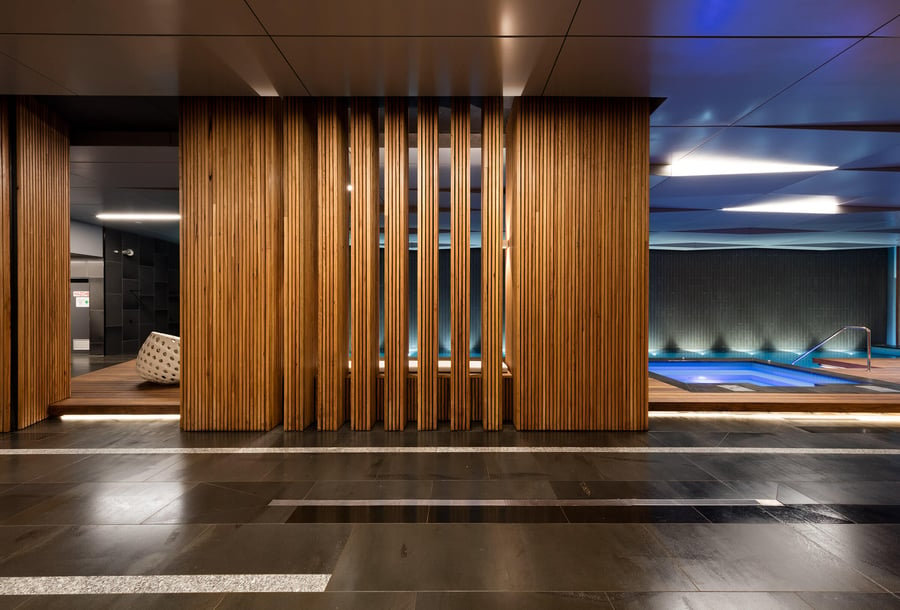14 January 2024

The use of timber in wet areas is often a popular design choice as it brings a sense of serenity and relaxation to the area. Timber is a pretty sturdy material, but water is one element that may cause it to deteriorate quickly.
Wet areas often contain moisture and humidity, which can affect the timbers’ structural integrity and longevity if not designed and maintained correctly. In this editorial you will discover how to correctly design with timber in wet areas to help ensure a flawless design.

Areas near pools, spas and bathrooms often contain environmental hazards which can affect timber within the design.
High-humidity: Humidity is high-moisture content in an environment, and if timber is not sealed correctly, it can cause widespread damage. Timber can also expand when moisture content increases.
Timber movement: High amounts of moisture in an environment can cause timber pieces to warp, bend and expand as they adjust to the environments equilibrium moisture content (EMC).
Rust & Galvanic Corrosion: Galvanic corrosion can occur when using a fixing system containing two types of metals. This process occurs when two dissimilar metals are immersed in a conductive solution and are electrically connected.
Mould Growth: If a piece of timber is not sealed correctly or the wrong species is selected, mould growth may occur. Adding a warm environment to this scenario can further fuel growth.
Water Absorption: If timber is incorrectly sealed, water can infiltrate it, causing rot, discolouration and leaching (see below).
Leaching: Leaching occurs when timber releases its natural oils and resins when exposed to moisture, as the tannins and extractants are released. This can cause unsightly brown, black or rusty looking ‘bleed’ marks on nearby surfaces.


Sealing and waterproofing timber with a quality coating prevents moisture and humidity from infiltrating the timber and can help avoid an array of issues. Warping, expansion, mould growth and leaching are less likely to occur on sealed timber, as these are all caused by water infiltration.
The coatings we recommend for use in wet areas include Clear Oil, Enviropro and Rubio, which we offer pre-applied to our timber products. They all provide sufficient protection to the timber from moisture, with Rubio and Clear Oil also containing anti-fungal properties that cannot crack or peel. We do not recommend Clear Poly for use in wet environments as it does not offer a high enough level of protection.
Timber movement can occur since pool environments have high moisture and humidity levels, therefore we recommend installing the timber with multiple fixings in place. Timber is fixed onto our mounting tracks, which are made from alloy/aluminium and is powder-coated which acts as a protective barrier in wet areas. We can also easily add extra tracks during installation for added stability.
A challenge faced in wet areas is that when two different metals connect they face what is known as ‘galvanic corrosion’. Our recommendation is to utilise a nylon washer at the point of contact of the two dissimilar metals to break up the connection. This vastly reduces the risk of rust forming.

Solid timbers with a tight grain are best for pool environments as they are less likely to be affected by moisture. Spotted Gum is suitable, provided it is adequately coated. Their suitability is due to the high resistance to mould growth and degradation. We would not recommend Australian Ash or American Oak in a wet area.
As a coating is integral to timbers ability to repel the majority of the concerns in wet areas, we strongly recommend a regimented inspection protocol at least every six months.
A great way to test a coatings efficacy is a water bead test, To do this, you take a glass of water, dip your hand in and flick water on the surface of the timber. If the water repels and does not absorb, then your coating is still protecting the timber. If the water absorbs into the timber, then a re-coat is required.
External applications need to follow coating manufacturer recommendations thoroughly. It is imperative that the coating is upheld on timber utilised in wet areas.
If you want to use cladding or battens in your pool area, we also offer aluminium as a durable, low maintenance option. Even if you want the look of timber, our aluminium Click-on battens and cladding can be wrapped in a wood finish to give the product the appearance of real timber.
We offer timber-look options across all profiles of our aluminium Click-on battens. Both of these options provide a natural timber aesthetic while taking advantage of the strengths of aluminium.
The ceiling shown below at FV by Peppers uses our wood finish aluminium to provide the realistic aesthetic of timber without needing to worry about issues such as movement or maintenance.

Our clients are at the heart of every project. It’s our job to deliver on the big picture and the smallest detail. We’re your proactive design partner – we’ll listen to what you need and will work with you to make sure your vision is achieved.
If you have any questions about designing in wet areas, you can contact us below.
